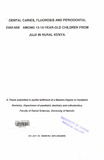| dc.description.abstract | INTRODUCTION: Major oral diseases afflicting children and adolescents are dental caries
and gingivitis. These diseases have been found to lead to a high morbidity of teeth in this age
group. There are also man-hours and school hours lost while seeking treatment for these
diseases, as children who are minors have to be accompanied by parents. Studies have
established that there is a linear relationship between fluoride exposure and dental fluorosis.
In Kenya over 30% of the population suffers from dental fluorosis and in isolated areas where
the people depend on ground water for domestic use over 100% of the population manifests
varying degrees of severity of dental fluorosis. Epidemiological studies have reported varied
findings on the association between dental fluorosis and dental caries experience. There are
few studies that have been conducted to associate periodontal disease and dental fluorosis.
MATERIALS AND METHODS: This was a descriptive cross-sectional study designed with
the aim of determining the oral health status of children aged 12-15 years in a rural area in
Kenya. A total of 225 primary school children from a rural school in Kalimoni sublocation, Juja
location, Ruiru division, Thika District, Central Province of Kenya were included in the study.
Juja area was purposively selected, as it is known to have ground water as a major source of
domestic water supply. Simple random sampling technique was used to select the schools.
Oral examination was conducted in a classroom under natural light. The child was seated
near the window to improve visibility, dental probes and mirrors were used for examination.
The Thylstrup and Fejerskov (1978)1 Index(TFt) was used to score for dental fluorosis. Dental
caries and periodontal status were assessed using the Decayed Missing Filled Teeth Index
(DMFT) and Community Periodontal Index (CPI) respectively in accordance with the World
Health Organization (WHO) criteria (1997).2 The data was recorded in a data collection form.
Water from the borehole and surface water in the area was sampled for fluoride and the
colorimetric method was used in the analysis of the fluoride levels.
RESULTS: A total of 225 children were included in the study of these 125 were males and
100 were females and the age range was 12-15 years with a mean of 13.28±1.11SD. The
prevalence of caries was 39.1% and the mean DMFT of the sample population was 1.51
±2.25SD. The mean decayed component was 1.48 and none of the children had any filled
teeth. The mean DMFT of the children with fluorosis and those without fluorosis was 1.44 and
1.55 respectively. Dental fluorosis was present in 50.7% of the sample population, of all the
teeth examined 51.9% scored TFI score 0, while 40.4% scored TFI score1-4 and 8.7% scored
TFI score ~5.The fluoride levels in surface water were O.2ppm and 3.6ppm in the borehole
water. There was no association between caries experience and dental fluorosis, the odds
ratio was 1.080(95%CI 0.6-1.8). The distribution of the CPt scores among the children
showed that CPI score O(healthy), CPIscore1 (gingivitis) and CPI score2 (gingivitis and
calculus) were present in 24.4%, 51.6% and 75.6% respectively. The children with fluorosis
tended to have a higher prevalence of gingivitis and there was a statistical significant
difference in the occurrence of gingivitis in all sextant except the upper right and lower
anterior when the teeth with fluorosis and those without were compared. The more severe the
level of fluorosis the higher was the risk of gingivitis.
DISCUSSION: The prevalence of dental caries was 39.1% with none of the children having
any filling done .The lack of any dental restorative treatment on any of the childten could be
due to the low dental health awareness and inaccessibility to dental health facilities and
unaffordability of restorative treatment due to the low income earned by the parents. The
lower prevalence of dental fluorosis could be explained by the fact that 67.1% of the
respondents used surface water for domestic use, which had low fluoride concentration
(O.2ppm.)The children in need of periodontal treatment were 76%, the high treatment need
could be due to low dental health awareness and poor oral hygiene practice. The higher
prevalence of gingivitis among the children with dental fluorosis could be hypothesized to be
due to the pitting and rough surfaces, which are not easily cleansable.
CONCLUSION: The prevalence of dental caries was 39.1% while the OMFT was 1.51±
2.2550 with a mean decayed component of 1.48 and there were no filled teeth. The
prevalence of dental fluorosis was 50.7% and the fluoride levels were 3.6ppm in the borehole
water and 0.2ppm in the surface water. CPI score 1(gingivitis) and CPlscore2 (gingivitis and
calculus) were respectively scored by 51.6% and 75.6% of the children examined. There was
an association between dental fluorosis and periodontal disease and there was no
association between dental fluorosis and dental caries.
RECOMMENDATION: Implementation of preventive oral health programs in the study area
as well as provision of accessible dental health facilities. Provision of alternative source of
water through initiati community based water supply programs. Recommend future
studies to establis the relationship between dental caries and fluorosis based on the
surfaces of the teeth examined. | en |

